Civil recovery suits are essential in ensuring justice when one party owes money or property to another. Imagine lending someone a substantial sum of money, and they refuse to pay it back. Frustrating, right? This is where civil recovery suits come into play, offering a legal remedy to recover what’s rightfully yours. The Indian Constitution, through various laws and principles, provides a robust framework for these suits, ensuring that justice is accessible and efficient.
Legal Framework Governing Civil Recovery Suits in India
India’s legal landscape for civil recovery is vast and comprehensive. The Indian Contract Act, 1872, outlines the basics of legally binding agreements. The Civil Procedure Code, 1908, provides detailed steps for filing and pursuing a suit. The Specific Relief Act, 1963, offers remedies beyond mere monetary compensation. Together, these statutes create a detailed legal framework that guides individuals and businesses in recovering their dues, ensuring fairness and order in transactions.
Constitutional Provisions Related to Civil Recovery
Our Constitution safeguards various rights that support civil recovery. Article 300A guarantees the right to property, emphasizing that no person shall be deprived of their property save by authority of law. Articles 32 and 226 empower citizens to approach the Supreme Court and High Courts for enforcing their rights, making the justice system accessible. The Directive Principles of State Policy, although non-justiciable, guide the creation of laws ensuring economic justice. These provisions collectively fortify the right to seek redress and recovery through legal means.
Types of Civil Recovery Suits
Civil recovery suits in India are diverse. They range from recovering money lent or due under a contract, reclaiming property wrongfully held by another, seeking compensation for damages caused by breach of contract, to restitution claims where the court orders the restoration of the plaintiff’s original position. Each type of suit has its nuances and requires a strategic approach, making the process both challenging and interesting for legal practitioners.
Procedure for Filing a Civil Recovery Suit
Filing a civil recovery suit begins with a legal notice demanding the owed amount or property. Choosing the right court is crucial, typically based on the value of the claim and the jurisdiction where the cause of action arose. The plaint, a formal statement of the plaintiff’s claims, must be meticulously drafted. Court fees, calculated based on the claim’s value, must be paid. Once filed, the court issues summons to the defendant, setting the stage for the legal battle ahead.
Defendant’s Response and Counterclaims
Upon receiving the summons, the defendant must file a written statement, their formal response to the plaint. This document can include various defenses, such as denial of the claim or justification for non-payment. Additionally, the defendant may file counterclaims or set-offs, turning the tables and demanding something from the plaintiff. This exchange of documents and claims lays the groundwork for the trial, making the process dynamic and engaging.
Trial and Evidence
The trial phase is where the action unfolds. Parties present their arguments, examine each other, and produce evidence. The burden of proof lies with the plaintiff, who must establish their claims convincingly. Witnesses are examined and cross-examined, and documentary evidence is scrutinized. This phase is crucial, as the quality of evidence and the skill of advocacy can significantly influence the outcome.
Judgment and Decree
After the trial, the court pronounces its judgment, based on the merits of the case. The decree, a formal expression of the court’s decision, can be preliminary or final. It outlines the obligations of the parties, such as payment of money or transfer of property. Enforcement of the decree is the next step, where the victorious party ensures compliance, often involving additional legal steps if the losing party is non-cooperative.
Appeals and Revisions
Not satisfied with the judgment? The Indian legal system allows for appeals. An aggrieved party can challenge the decision in a higher court, provided there are substantial grounds for appeal. The appellate process involves a review of the lower court’s decision, focusing on errors in law or procedure. Revisions and reviews are also possible, ensuring that justice is not compromised by mistakes or oversights.
Alternative Dispute Resolution (ADR) Mechanisms
Litigation can be time-consuming and expensive. Alternative Dispute Resolution (ADR) offers efficient and less adversarial options like arbitration, mediation, and conciliation. Lok Adalats, or people’s courts, provide a platform for amicable settlements. These mechanisms are encouraged by the judiciary to reduce the burden on courts and promote quicker resolutions, making justice more accessible and less burdensome.
Case Laws and Precedents
Judicial precedents play a vital role in civil recovery suits. Landmark judgments by the Supreme Court and High Courts provide guidance on interpreting laws and principles. Cases like “Sushil Kumar vs. Joy Mathew” and “Sahara India vs. SEBI” have shaped the legal landscape, offering clarity and direction for future litigations. These precedents ensure consistency and predictability in legal outcomes.
Challenges and Issues in Civil Recovery Suits
Despite a robust legal framework, challenges persist. Delays in the judicial process can be frustrating, often prolonging the agony for plaintiffs. Enforcing decrees can be another hurdle, especially if the defendant is uncooperative or insolvent. Fraudulent transfers and concealment of assets further complicate recovery. Addressing these issues requires persistence and strategic legal manoeuvring.
Reforms and Recommendations
Judicial reforms are crucial for a more efficient civil recovery system. Speeding up case disposal through fast-track courts and digital initiatives can reduce delays. Legislative amendments to simplify procedures and enhance enforcement mechanisms are necessary. Embracing technology, such as e-filing and virtual hearings, can streamline processes. Strengthening ADR mechanisms will also alleviate the burden on courts and provide quicker resolutions.
Civil recovery suits are pivotal in ensuring justice and fairness in financial and property matters. The Indian Constitution, supported by comprehensive statutes and judicial precedents, offers a solid foundation for these suits. Despite challenges, continuous reforms and the adoption of innovative solutions promise a more efficient and accessible justice system. The future looks promising, with ongoing efforts to refine and enhance the legal framework.




